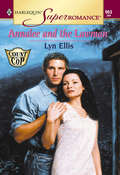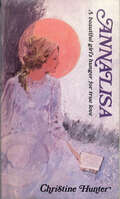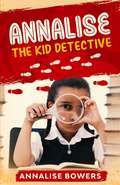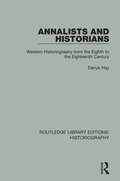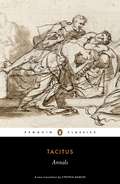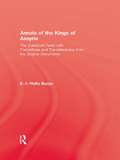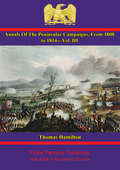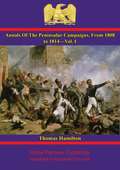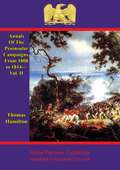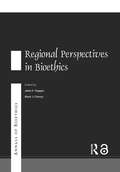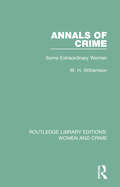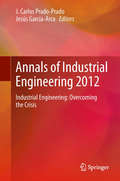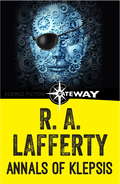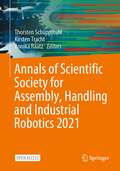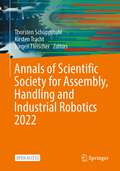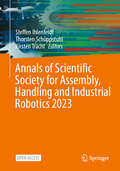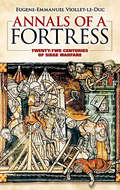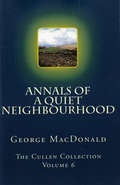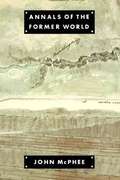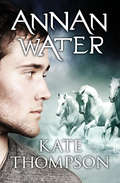- Table View
- List View
Annalee and the Lawman
by Lyn EllisOn Rain Mountain lives a lady, Who she is they do not know. All she wants is to be left alone... No one knows the Crazy Woman of Rain Mountain. And that's just fine with Annalee Evans. She went to the mountains because they were a good place to hide. Besides, she doesn't need anyone in her life; she already has three friends -- her two Dobermans and a shotgun. Deputy Ben Ravenswood would certainly be Annalee's friend -- or more -- if she'd let him. Annalee almost believes she can trust him, but she's been burned once too often in the past. Then a runaway shows up at Annalee's cabin, reminding her of a little girl who long ago needed someone to care. Helping the girl means turning to Ben and opening her safe haven to strangers. Much as she wants to, Annalee just can't close the door....
Annalisa: A Beautiful Girl's Hunger for True Love
by Christine HunterAnnalisa is the story of a woman who, betrayed by her own beauty, discovers true beauty in Christ. Packed with frustration, hate, sorrow, and love, this true story will touch your heart.
Annalisa: A Beautiful Girl's Hunger for True Love
by Christine HunterAnnalisa is the story of a woman who, betrayed by her own beauty, discovers true beauty in Christ. Packed with frustration, hate, sorrow, and love, this true story will touch your heart.
Annalise The Kid Detective
by Annalise BowersWhen it comes to solving mysteries, Annalise The Kid Detective is on the case! Using her uncanny talents, she can dig up things when everyone else has given up. With her unique team by her side, including her mother and other kid detectives, Annalise not only helps find missing items, but helps people discover the missing message behind their item. The Box Annalise’s teacher is excited about the box of books she brought to class. Each student will get a personalized book that could change their lives forever. But before she can distribute them, someone steals the box! While everyone else panics, AKD is on the case! What she finds may open magical doors the students never thought possible. The Book Everyone is enjoying their personalized book, including Annalise, who’s excited about where the book is guiding her. But when she misplaces her beloved book, she’s devastated. Along with a colorful cast of characters, she goes on a journey of discovery to find the book and inspiration at every turn. The Key When a married couple hosts a dinner party, they take a moment to show their unique box, which holds a magical stone. After the party, they discover the key to open the box is missing! They hire Annalise The Kid Detective. As she does her best to keep tempers at bay and accusations from flying, she helps the couple locate the missing key and discover that things aren’t always what they seem. The Stone A magic stone that allows you to talk to people who have gone to Heaven is making news across the country. When it comes up missing after being displayed at a children’s art festival, Annalise The Kid Detective is the only hope to get it back. More than just light-hearted magical stories, their page-turning tables from debut pre-teen author Annalise Bowers will have you craving for more!
Annalists and Historians: Western Historiography from the VIIIth to the XVIIIth Century (Routledge Library Editions: Historiography #17)
by Denys HayThis book, originally published in 1977, is a survey of European historiography from its origins in the historians of Greece and Rome, through the annalists and chroniclers of the middle ages, to the historians of the late eighteenth century. The author concentrates on those writers whose works fit into a specific category of writing, or who have inlfuence the course of later historical writing, though he does deal with some of the more specialist forms of medieval historiography such as the crusading writers, and chivalrous historians like Froissart. He maintains that ‘modern’ history did not develop until the 18th Century.
Annals
by TacitusA compelling new translation of Tacitus' Annals, one of the greatest accounts of ancient Rome, by Cynthia Damon.Tacitus' Annals recounts the major historical events from the years shortly before the death of Augustus to the death of Nero in AD 68. With clarity and vivid intensity Tacitus describes the reign of terror under the corrupt Tiberius, the great fire of Rome during the time of Nero and the wars, poisonings, scandals, conspiracies and murders that were part of imperial life. Despite his claim that the Annals were written objectively, Tacitus' account is sharply critical of the emperors' excesses and fearful for the future of imperial Rome, while also filled with a longing for its past glories.This new Penguin Classics edition also includes chronologies, notes, appendices, a genealogy and an introduction discussing Tacitus's life and his approach to history.
Annals Of The Kings Of Assyria
by BudgeCollected for the first time by the eminent scholar E. A. Wallis Budge, this work contains all of the written records of the early Assyrian kings, from the reign of Irishum in about B.C. 2000 to the reign of Ashur-nasir-pal, which ended in B.C. 860. The texts are presented in Assyrian with complete English translations and, where appropriate, photographs of the original inscriptions. Budge supplements the texts with discussions of their historical and anthropological contexts, as well as notes on the problems encountered in translation. For its thoroughness and for the fascinating insights it provides, this work remains indispensable to anyone with a serious interest in ancient civilizations.
Annals Of The Peninsular Campaigns, From 1808 To 1814—Vol. III (Annals Of The Peninsular Campaigns, From 1808 To 1814 #3)
by Thomas HamiltonWhen Thomas Hamilton set out to write this detailed history of the Peninsular campaigns, the great struggle for Portugal and Spain was still fresh in the minds of his intended audience. It was also seared on his own memory from his service in the war as an ensign and later lieutenant of the 29th Regiment of Foot. He served at the first siege of Badajoz, at the butchery of Albuera, where he was severely wounded, and, after his recovery, in the battles around the Pyrenees. Following his military service, he turned to writing, penning the noted military novel Cyril Thornton, and was a frequent contributor to "Blackwood's Magazine". The Annals were positively received by critics of his own time and were written with much detail from eye-witness accounts amongst his contacts in the military and literary circles that he moved in. They form an excellent and readable account of the military and political events of the Peninsular War and are less critical and argumentative than others written around the same period.This third volume takes the action from Late 1810 to 1814.Illustrations - 7 maps.
Annals Of The Peninsular Campaigns, From 1808 to 1814—Vol. I (Annals Of The Peninsular Campaigns, From 1808 to 1814 #1)
by Thomas HamiltonWhen Thomas Hamilton set out to write this detailed history of the Peninsular campaigns, the great struggle for Portugal and Spain was still fresh in the minds of his intended audience. It was also seared on his own memory from his service in the war as an ensign and later lieutenant of the 29th Regiment of Foot. He served at the first siege of Badajoz, at the butchery of Albuera, where he was severely wounded, and, after his recovery, in the battles around the Pyrenees. Following his military service, he turned to writing, penning the noted military novel Cyril Thornton, and was a frequent contributor to "Blackwood's Magazine". The Annals were positively received by critics of his own time and were written with much detail from eye-witness accounts amongst his contacts in the military and literary circles that he moved in. They form an excellent and readable account of the military and political events of the Peninsular War and are less critical and argumentative than others written around the same period.This first volume takes the action from the opening of the War to November 1808.Author -- Hamilton, Thomas, 1789-1842.Text taken, whole and complete, from the edition published in 1831, Edinburgh by William Blackwood and T. Cadell, Strand, London.Original Page Count - xi and 388 pages.Illustrations - 3 maps.
Annals Of The Peninsular Campaigns, From 1808 to 1814—Vol. II (Annals Of The Peninsular Campaigns, From 1808 to 1814 #2)
by Thomas HamiltonWhen Thomas Hamilton set out to write this detailed history of the Peninsular campaigns, the great struggle for Portugal and Spain was still fresh in the minds of his intended audience. It was also seared on his own memory from his service in the war as an ensign and later lieutenant of the 29th Regiment of Foot. He served at the first siege of Badajoz, at the butchery of Albuera, where he was severely wounded, and, after his recovery, in the battles around the Pyrenees. Following his military service, he turned to writing, penning the noted military novel Cyril Thornton, and was a frequent contributor to "Blackwood's Magazine". The Annals were positively received by critics of his own time and were written with much detail from eye-witness accounts amongst his contacts in the military and literary circles that he moved in. They form an excellent and readable account of the military and political events of the Peninsular War and are less critical and argumentative than others written around the same period.This second volume takes the action from Late 1808 to October 1810.Author -- Hamilton, Thomas, 1789-1842.Text taken, whole and complete, from the edition published in 1831, Edinburgh by William Blackwood and T. Cadell, Strand, London.Original Page Count - iv and 367 pages.Illustrations - 4 maps.
Annals of Bioethics: Regional Perspectives In Bioethics (Routledge Annals of Bioethics)
by Mark J. Cherry John F. PeppinRegional Perspectives in Bioethics" illustrates the ways in which the national and international political landscape encompasses persons from diverse and often fragmented moral communities with widely varying moral intuitions, premises, evaluations and commitments.
Annals of Crime: Some Extraordinary Women (Routledge Library Editions: Women and Crime #5)
by W. H. WilliamsonThis title, first published in 1930, examines the events of eleven female criminals and the conditions that surrounded their crimes. Annals of Crime explores whether the women mentioned would have committed these crimes if their circumstances had been different. This book will be of interest to students of history, criminology and gender studies.
Annals of Industrial Engineering 2012: Industrial Engineering: overcoming the crisis
by J. Carlos Prado-Prado Jesús García-ArcaProceedings of the 6th International Conference on Industrial Engineering and Industrial Management and the XVI Congreso de Ingeniería de Organización (CIO 2012). The aim of CIO is to establish a forum for the open and free exchange of ideas, opinions and academic experiences about research, technology transfer or successful business experiences in the field of Industrial Engineering. The CIO 2012 is an annual meeting promoted by "Asociación para el Desarrollo de la Ingeniería de Organización" (Industrial Engineers Association, ADINGOR) with a Scientific Committee composed of 61 international referees and more than 200 professionals from 7 countries. A selection of the lectures and presentations made over three days by researchers and practitioners from different countries are presented here. A range of topics is covered including: A selection of the lectures and presentations made over three days by researchers and practitioners from different countries are presented here. A range of topics is covered including: · Business Administration & Economic Environment · Technological & Organizational Innovation · Logistics & Supply Chain Management · Production & Operations Management · Management Systems & Sustainability The conference in Industrial Engineering (CIO) and its proceedings are an excellent platform for the dissemination of the outputs of the scientific projects developed in the frame of the International Research and Development plans.
Annals of Klepsis
by R. A. LaffertyOH COME TO KLEPSIS TO CLAIM YOUR SHARE ... AND BREATHE THE RANK AND LAWLESS AIR!Plots and intrigues and romances abound.Smoke pictures, ghosts and treasure chests to be found.Magnifying monocles and hallucinogenic grapes - the unvoiced dreams of the dregs of space.Long John Tony Tyrone, the peg-legged historian, journeys here...And marries a princess with rainbow hair.But the Ghost of Christopher Brannagan will not restUntil mathematician Aloysius has put to the testHis theory concerning the Doomsday EquationWhich might save the plane from total devastation.Or might not.
Annals of Scientific Society for Assembly, Handling and Industrial Robotics 2021
by Thorsten Schüppstuhl Kirsten Tracht Annika RaatzThis Open Access proceedings presents a good overview of the current research landscape of assembly, handling and industrial robotics.The objective of MHI Colloquium is the successful networking at both academic and management level. Thereby, the colloquium focuses an academic exchange at a high level in order to distribute the obtained research results, to determine synergy effects and trends, to connect the actors in person and in conclusion, to strengthen the research field as well as the MHI community. In addition, there is the possibility to become acquatined with the organizing institute. Primary audience is formed by members of the scientific society for assembly, handling and industrial robotics (WGMHI).
Annals of Scientific Society for Assembly, Handling and Industrial Robotics 2022
by Jürgen Fleischer Thorsten Schüppstuhl Kirsten TrachtThis Open Access proceedings presents a good overview of the current research landscape of assembly, handling and industrial robotics.The objective of MHI Colloquium is the successful networking at both academic and management level. Thereby, the colloquium focuses an academic exchange at a high level in order to distribute the obtained research results, to determine synergy effects and trends, to connect the actors in person and in conclusion, to strengthen the research field as well as the MHI community. In addition, there is the possibility to become acquatined with the organizing institute. Primary audience is formed by members of the scientific society for assembly, handling and industrial robotics (WGMHI).
Annals of Scientific Society for Assembly, Handling and Industrial Robotics 2023
by Thorsten Schüppstuhl Kirsten Tracht Steffen IhlenfeldtThis open access book presents a good overview of the current research landscape of assembly, handling and industrial robotics. The objective of MHI Colloquium is the successful networking at both academic and management levels. Thereby, the colloquium focuses an academic exchange at a high level in order to distribute the obtained research results, to determine synergy effects and trends, to connect the actors in person and in conclusion, to strengthen the research field as well as the MHI community. In addition, there is the possibility to become acquainted with the organizing institute. Primary audience is formed by members of the scientific society for assembly, handling and industrial robotics (WGMHI).
Annals of a Fortress: Twenty-two Centuries of Siege Warfare
by Eugene-Emmanuel Viollet-le-Duc Benjamin BucknallCombining the excitement of a novel with the authenticity of a historical document, this gripping book chronicles a castle's rise from obscurity to international attention during the nineteenth century. It profiles a fictional fortress, La Roche-Pont, for an unusual survey of the evolving art of siege warfare--from Gallic tribes attempting to hold off the might of the Roman empire through medieval feuds, protracted religious conflicts of the seventeenth century, and the Napoleonic and Franco-Prussian Wars.The noted architect Eugene-Emmanuel Viollet-le-Duc (1814-1879) was in a unique position to write this book. A central figure in France's Gothic Revival, Viollet-le-Duc had a second career in the military that included a prominent role in the defense of Paris during the Franco-Prussian War of the 1870s. With this accessible, well-researched study, he exerted an enduring influence on French military defensive thinking. Subtle and enchanting in its blend of fact and fiction, Annals of a Fortress continues to offer a brilliant evocation of more than 2,000 years of European warfare.
Annals of a Quiet Neighborhood (The Cullen Collection #6)
by George MacDonaldThe story of a young minister and his flock—first in the Scottish author&’s Marshmallows Trilogy including The Seaboard Parish and The Vicar&’s Daughter. MacDonald&’s first major English novel, published in 1867, was set in the village of Arundel on the downs south of London near the south channel coast. It was the site of MacDonald&’s first and only pastorate as a newly married minister in 1851-53. This book is wonderfully descriptive of the region, with autobiographical hints of MacDonald&’s outlook as a young pastor. Chronicling the daily life of one of MacDonald&’s fictionalized &“ideal ministers&”—perhaps a portrayal of the shepherd-pastor MacDonald had himself hoped to be—the Annals proved one of his most popular novels. First released in the Sunday Magazine, which was intended for &“Sabbath reading,&” Annals of a Quiet Neighbourhood was quickly published in numerous book editions and contributed in a significant way to MacDonald&’s growing popularity in America. Though less spine-riveting of plot, the three volumes of the Marshmallows Trilogy spawned by Annals provide some of MacDonald&’s most homiletic and deeply spiritual writings.
Annals of an Abiding Liberal
by John Kenneth Galbraith Andrea D. WilliamsAddresses, essays, lectures on economic policy, economic affairs, Galbraith's personal history, several authors, and the arts - a mixed bag by the famous economist.
Annals of the Former World
by John McpheeJohn McPhee describes a cross-section of North America and comes to an understanding not only of the science but of the style of the geologists he traveled with. Completed in four stages under the collected title: Annals of the Former World. <P><P> Winner of the Pulitzer Prize.
Annals of the Time Patrol
by Poul AndersonMEN WANTED 21-40, pref. single, mil. or tech. exp., good physique, for high-pay work with foreign travel. Engineering Studies Co., 305 E. 45, 9-12 & 2-6. To Manson Emmert Everard, 30-year-old veteran, engineer, bachelor, outdoorsman--and decidedly independent spirit--it sounds like an ideal opportunity. Especially the foreign travel. But, as he steps into the office, he has no idea how foreign. For Manse Everard is being recruited for the Time Patrol. Once accepted, Manse is ferried by time shuttle to the Academy, the Time Patrol training center set in the ancient Oligocene period. There he learns how time travel had been discovered in a turbulent far-future by the Nine--who saw in it sinister possibilities--and how the mysterious Danellians had stopped them. And how, to prevent abuse of the time lanes by the foolish and the greedy, the Time Patrol had been formed. "Your work will mostly be within your own eras,"^' his class is told. "You will live ordinary lives, family and friends as usual--But you will always be on call!" Returning to a cover job at the Engineering Studies Co., Manse finds the 20th century a springboard to danger, adventure and intrigue, contained here in five now-classic tales and two exciting new novellas. Join Manse as he rescues a 20th-century archeologist reluctantly enthroned in ancient Persia--sabotages Kublai Khan's 13th-century expedition to North America... returns New York to its rightful history... seeks to foil bandits holding the ancient city of Tyre for ransom -- Annals of the Time Patrol is an adventure lover's delight, a 2-in-1 volume including The Guardians of Time and Time Patrolman.
Annan Water
by Kate ThompsonMichael is inexplicably drawn to Annie, but a deep and mysterious river divides themMichael Duggan feels lost. After the death of his younger sister in a riding accident, his parents have relocated their family and their horse-dealing business to Scotland. Days and nights are taken up with caring for the horses and ponies, showing them to buyers, and competing in shows. School is a blur—Michael has no friends and no clear sense of who he is. He feels completely alone in the world, until he meets Annie, a girl who, like him, seems to want to flee from something; a girl who has dark secrets of her own. Michael desperately wants to be with Annie. But she lives on the opposite side of the treacherous Annan Water . . .
Annan Water
by Kate ThompsonMichael is inexplicably drawn to Annie, but a deep and mysterious river divides themMichael Duggan feels lost. After the death of his younger sister in a riding accident, his parents have relocated their family and their horse-dealing business to Scotland. Days and nights are taken up with caring for the horses and ponies, showing them to buyers, and competing in shows. School is a blur—Michael has no friends and no clear sense of who he is. He feels completely alone in the world, until he meets Annie, a girl who, like him, seems to want to flee from something; a girl who has dark secrets of her own. Michael desperately wants to be with Annie. But she lives on the opposite side of the treacherous Annan Water . . .
